Some photographers still rely on film photography because of its nostalgic and aesthetic approach to capturing images. However, cutting-edge technology in digital cameras has shaped the standards with its premium qualities to capture film-like images.
Therefore, digital cameras bring flexibility to have aesthetic photography to achieve unique preferences and needs. Also, Because of the ever-rising prices and non-availability of film, it’s essential to have the best budget-friendly cameras. So, this guide will list the best digital cameras that ensure creativity and are more convenient.
Key Factors to consider before choosing the cameras
The right camera is paramount to achieving convenience, budget-friendliness, and higher lens compatibility. Therefore, it’s pivotal for professionals to understand the critical factors before making an informed decision about different digital cameras.
Battery
One of the primary aspects of a camera battery is to ensure convenience and uninterrupted shooting for extended periods. Moreover, better battery health is crucial to smoothening the process to avoid interruptions or missed shots. For photographers, a more comprehensive battery is essential for seamless travel or challenging shooting.
Resolution
In digital photography, the resolution is the critical factor measured in captured megapixels and defines the clarity of the image. In addition, higher resolution provides more flexibility and convenience in better optical zoom and post-processing cropping.
The resolution is vital in defining stability and better image quality with a clear distinction between two objects. So, the minimum accepted image resolution is 15 megapixels, providing better photos without disrupting pixels.
Lenses Compatibility
With wider compatibility, interchangeable lenses are preferred to ensure diversity in capturing different objects. For beginners, 18-55 mm focal length lenses capture better image quality, which is far from the site. Because of adaptability and specialty lenses, compatibility with existing models is crucial for autofocus and specialization features.
Price
Price is the pivotal factor determining the camera choice and its performance or image quality. There is often a misconception that expensive cameras provide better image quality than cheaper or budget-friendly cameras.
However, with technological innovations, making an informed decision according to your needs and budget is preferred. Therefore, it’s essential to understand the balance between cost and camera features that will meet your expectations of better photography.
The Best Digital Camera that Takes Pictures Like Film | Top 9
From cost-effective solutions to seamless shooting experience, digital cameras ensure a smooth and more extended shooting period. For photographers looking for a budget-friendly combination of digital cameras and film photography. So, hereunder is a careful combination of diverse cameras that will elevate your shooting experience.
Fujifilm X- T 30 II
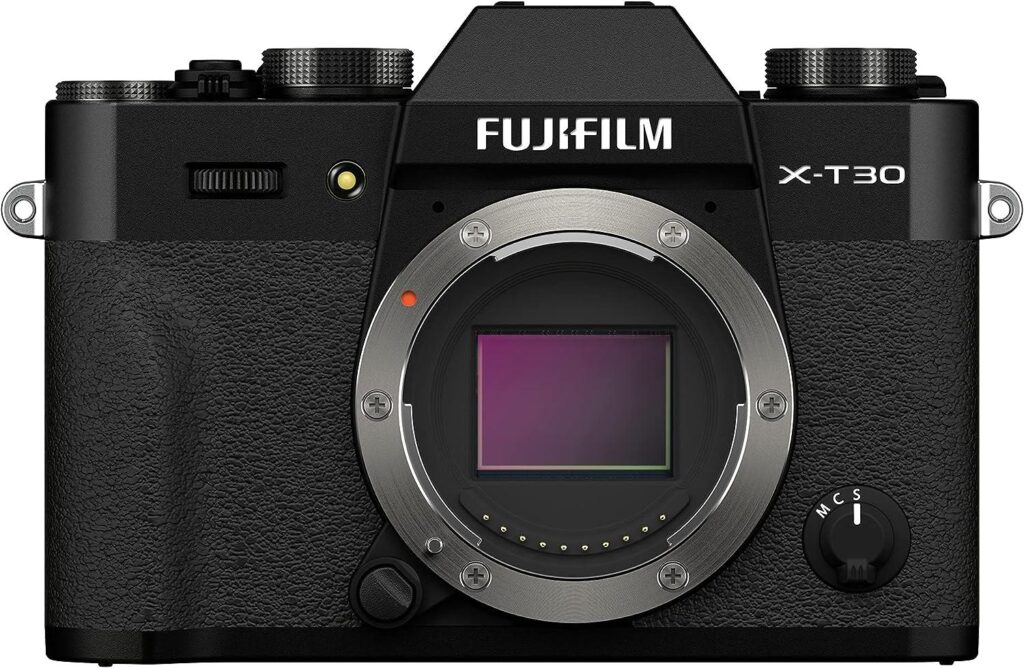
The lightweight design and cutting-edge technology of the X-T 30 will bring an immersive experience, ensuring creativity. It offers next-generation wireless Wi-Fi and Bluetooth 4.2 connectivity for professionals for digital communication. The intelligent fourth-generation CMOS 4 Sensor and Processor minimizes the noise with its color filter array.
Moreover, its advanced autofocus technology with phase detection pixels ensures that every pixel has speed and precision. Its high-speed tracking captures fast-moving colors and objects regardless of low-light or night-time shooting conditions.
Pros:
- Wireless Connectivity
- High-quality Film Simulation
- 30fps capture with tracking focus
- 26.1 MP CMOS imaging
Cons:
- Average Battery Life
- Not ideal for Vlog-style video
- Short Viewfinder
With a cinematic aspect ratio of 17:9, it provides a high resolution of 4k to 6k with low image noise. Furthermore, its 18 different Film Simulations and motion pictures are essential for creating movies. Its high smartphone compatibility saves time and data by compressing the images and seamlessly transferring them from your camera.
Quantitative Measurements:
- Connectivity: 9/10
- Materials: 9.5/10
- Portability: 9/10
- Uniqueness: 9.5/10
Kodak PIXPRO AZ405
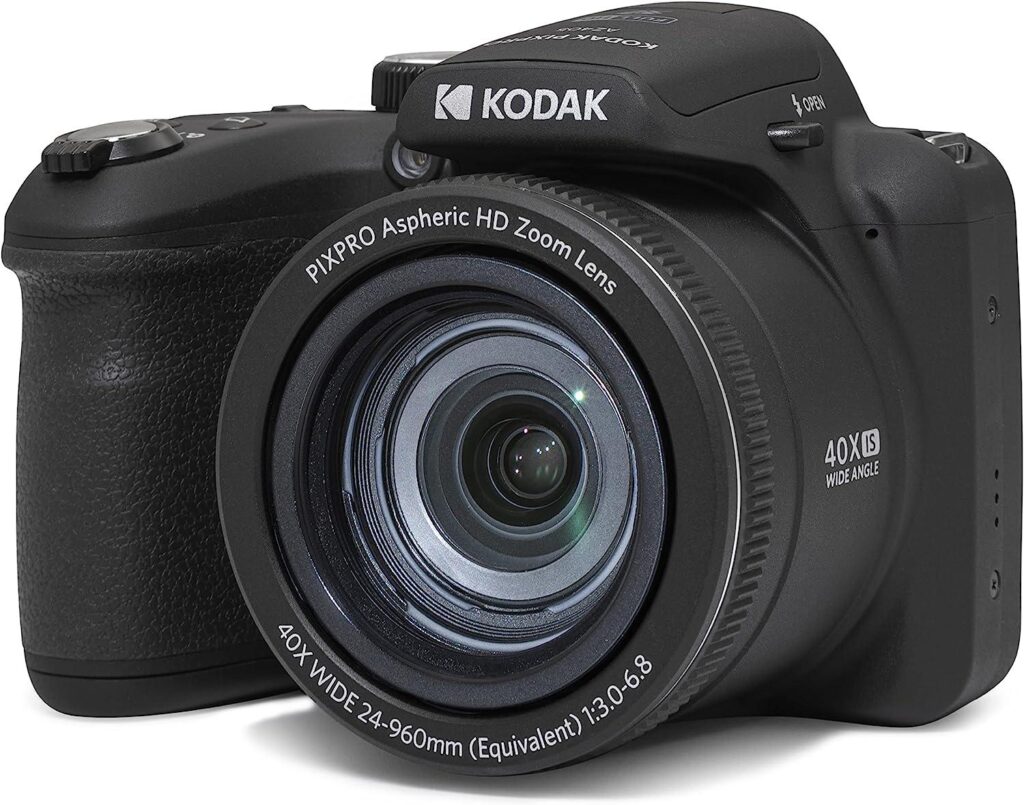
For a classical photography experience, Kodak PIXPRO will provide crisp, clear, and high-quality images with its 20 megapixels. Moreover, the Optical Image Stabilization with its 40x long zoom lens ensures object tracking with perfection. It minimizes the noise by focusing on difficult light conditions with wider focal lengths.
Its dynamic focal length range of 24-960mm, covering wide-angle to telephoto, will bring high-resolution images. Therefore, it ensures an easy-to-use and hassle-free photography experience and eliminates the need for post-editing.
Pros:
- Enhanced battery life
- 40x Optical and 4x Digital Zoom
- TTL Autofocus
- Better Image Quality
Cons:
- Camera Stabilization causes issues
- Not ideal for continuous use
Along with its 9-point autofocus, the 180⁰ panorama mode allows a broader composition to take in-depth images with perfection. The more comprehensive angle camera optimization sees what you see and provides a display with a brighter LCD screen. So, Kodak primarily focused on taking crisp pictures with its built-in flash and multi-detection modes.
Quantitative Measurements:
- Connectivity: 9/10
- Materials: 9/10
- Portability: 9.5/10
- Uniqueness: 9/10
Canon EOS R100

Regarding capturing film-like images, EOS R100 provides modern-day solutions with its 18-45mm wider lens. Moreover, it carefully analyzes the balance between high resolution, speed, and low light to achieve quality shooting. Also, the native ISO sensitivity of 100-12800 enhances low-light performance and the ability to capture at 6.5 fps continuously.
Despite ISO sensitivity, relying on something other than it alone while capturing low light conditions is essential, as it will result in grains. A 24.4 MP CMOS Image Sensor and AF System provide smooth accuracy with fast focusing for capturing memories.
Pros:
- Great image quality
- Easy to Use
- Wireless Control
- Compact and Lightweight Design
Cons:
- No touchscreen
- Can’t be charged while in use
Moreover, its Dual Pixel CMOS is designed to bring precision to each shot with critical focus during continuous shooting. It’s designed to capture RAW photos and wirelessly transfer them to your phone. The transfer is also widely compatible with many mobile devices and allows wireless control.
Quantitative Measurements:
- Connectivity: 8.5/10
- Materials: 9/10
- Portability: 9.5/10
- Uniqueness: 9/10
Sony Alpha A700

Sony Alpha redesigned the algorithm to modify the industry standards with a quick focus on moving objects. Moreover, its Super SteadyShot Image Stabilization system brings stability by moving the sensor in response to shakes. So, it can capture impossible shots with up to 4.0 stops to clarify the images in low-light conditions.
Its advanced technology CMOS Image Sensor provides 12 million pixels, and on-chip noise canceling ensures in-depth images. Also, it prevents photos from mirror bounce by intelligent focus, quick action of 3-5 fps, and 12.24 MP resolution.
Pros:
- Precise, Speed, and Accuracy
- High Sync Speed
- Anti-Dust Technology
- Built-in Flash
Cons:
- Limited Connectivity
- Lower Burst Rate
- Battery Drains Quickly
Additionally, a combination of optical glass prism and viewfinder lenses (Pentaprism Viewfinder) provides clarity to shots. Moreover, its Eye-Start Autofocus System makes autofocus adjustments precise by accurately detecting the eye.
The built-in Image Management software enables precise capture and storage of large-volume RAW images. So, the standardized and quick rechargeable battery ensures the smooth capture of 650 shots with precision.
Quantitative Measurements:
- Connectivity: 8.5/10
- Materials: 9/10
- Portability: 9.5/10
- Uniqueness: 8/10
Fujifilm X 10

With FujifilX10’s smaller size, it’s designed to build last and bring creativity to your smooth and more precise images. The 12-megapixel CMOS sensor processor captures high-quality images and is efficient in post-processing editing. The Intelligent CMOS provides fast-readout shooting of 7 fps at full resolution and 10 fps at 1080P resolution.
The 10’s exceptional technology can super-macro shooting of 1cm with its fast power setup of 0.8 seconds. Also, it provides 4x manual zoom and doubles the zoom capabilities with its Intelligent Zoom Technology.
Pros:
- 360-degree panoramic shooting
- Pop-up flash range of 7 meters
- Budget-friendly
- Quick Power Start-up
Cons
- Lack of weather sealing
- Focus system slows down
The Motion Panorama 360-degree provides diverse manual shooting modes, allowing you to switch between them easily. Therefore, its wider F2.0-2.8 lens ensures high-quality stabilized images in low light and provides a blurred background for portraits.
Moreover, it allows four diverse auto-bracketing functions for” “film simulation, ISO sensitivity, dynamic range, and exposure.” It provides various film simulation modes, for instance, eight settings that will elevate your experience with its film photos.
Quantitative Measurements:
- Connectivity: 8/10
- Materials: 9/10
- Portability: 9/10
- Uniqueness: 8.5/10
Panasonic Lumix G100
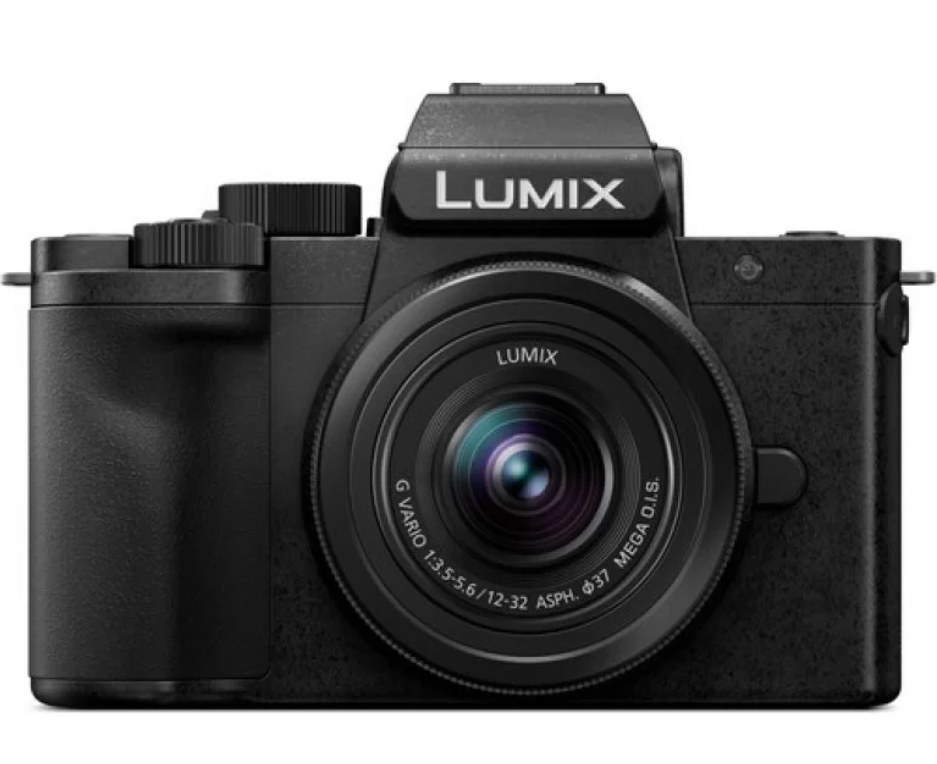
PanasoniG100’s wider 20.3MP Micro Sensor provides high-detailed photos without affecting the quality. Therefore, its 5-axis Image Stabilization system eliminates the camera shocks to bring smoothness during shooting. Additionally, after seamlessly integrating with the smartphone, Lumix ensures wireless control and transfer of quality images.
Its prime shutter effect makes it ideal for continuously capturing and selecting frames between videos at a 30-fps shooting rate. For this, its advanced DFD Technology intelligently tracks the distance and builds focus with eye-face detection.
Pros:
- Compact and Lightweight
- Easy to Control
- Great Image Quality
- Quick Facial Recognition
Cons:
- Battery Drains during continuous recording
- Struggles in low light conditions
Moreover, Lumix’s optical viewfinder with a focal length of f/3.5-5.6 and a wider 24-64mm zoom enhances the detection. Besides capturing photos, it’s perfect for traveling and precisely capturing crisp, clear images. Its compact and lightweight design makes it an excellent budget-friendly choice.
Quantitative Measurements:
- Connectivity: 8/10
- Materials: 9/10
- Portability: 8.5/10
- Uniqueness: 8/10
Olympus OM-D E-M10 Mark IV
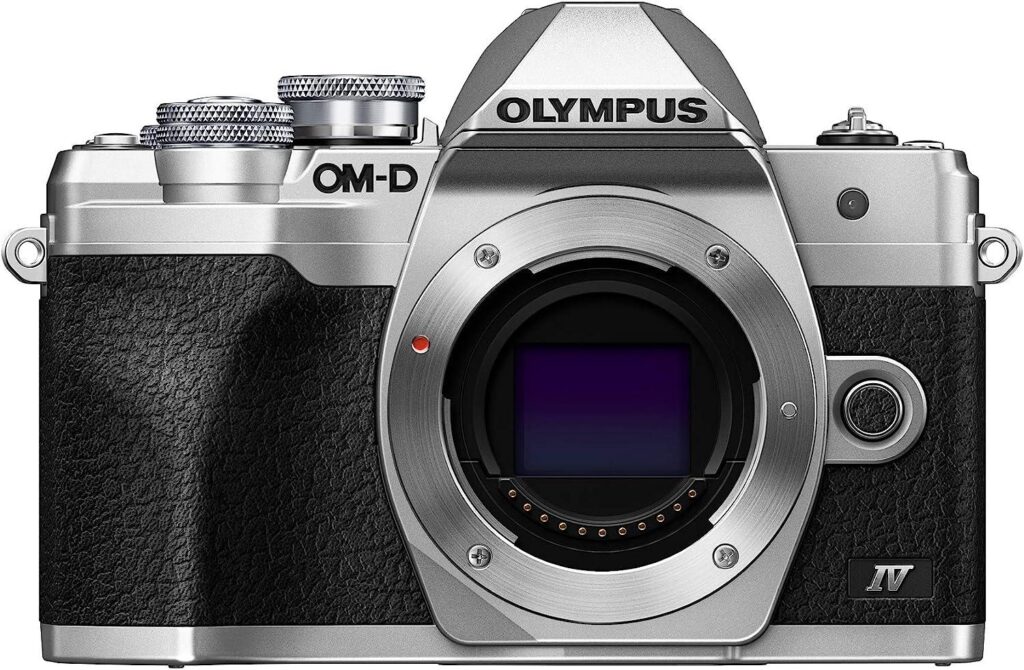
The Olympus Mark IV is best for a small, sleek, easy-to-carry camera. Its 5-axis Image Stabilization delivers a 4.5 shutter speed that captures still and moving objects. Therefore, it provides the freedom of movement to capture high-resolution images without affecting the quality.
Its intelligent algorithms bring accuracy to autofocus by primarily focusing on the face and eye. Therefore, it captures compressed RAW or processed photos for wirelessly sharing with the connected phone. With diverse shooting modes, from Grainy Film to Instant Film, it’s an excellent choice for photographers to capture film photography.
Pros:
- Enhanced CAF precision
- 4K at 30p and Full HD at 60P
- Electronic Viewfinder
- 121 AF Point
Cons:
- Battery drains quickly
- Plastic Body
Moreover, the intelligent combination of 20mp Live MOS Sensor and TruePic VIII Image Processor captures detailed movement. Also, it ensures an ISO range of 200-25600, making it ideal for recording and capturing high-resolution. Its ideal OLED Electronic Viewfinder distinguishes it from others to ensure eye-level viewing.
Quantitative Measurements:
- Connectivity: 8/10
- Materials: 8/10
- Portability: 8.5/10
- Uniqueness: 8/10
Nikon D200

Nikon’s industry-standard optical viewfinder magnifies clear and precise composition tailored to your eyesight. In addition, the 0.94x exact magnification provides an ultra-view angle of 170⁰ to capture all directions.
With a quick powering up and lightning speed of 0.15 seconds, it captures high-resolution images with dense color integration. Its CCD Image Sensor provides a unique color rendition with its digital image algorithms. With this, it will ensure the provision of smooth color gradations that will bring creativity to photography.
Pros:
- Shutter Speed of 1/8000s to 30s
- Robust and Compact Body
- CCD Image Sensor
- Higher Battery Life
Cons:
- Not ideal for Night Shooting
- Poor Autofocus System
Moreover, its 10.2 megapixels and five fps enhance the ability to capture high-quality images. The D200 lightweight and advanced technology magnesium alloy body protects it from moisture and dust. The DSLR provides good photos with better ISO performance and classic ASMR shutter sounds.
Quantitative Measurements:
- Connectivity: 8.5/10
- Materials: 7.5/10
- Portability: 8.5/10
- Uniqueness: 8/10
Hollyland VenusLiv
Before choosing any of the above cameras, let’s wrap up this topic by mentioning the Hollyland VenusLiv. VenusLiv sets its mark in digital content creation as one of the most heavy-duty cameras for streaming and video recordings with professional results. Made to provide high standards of film photography, this camera can capture high-quality visuals as if you’re watching a movie.
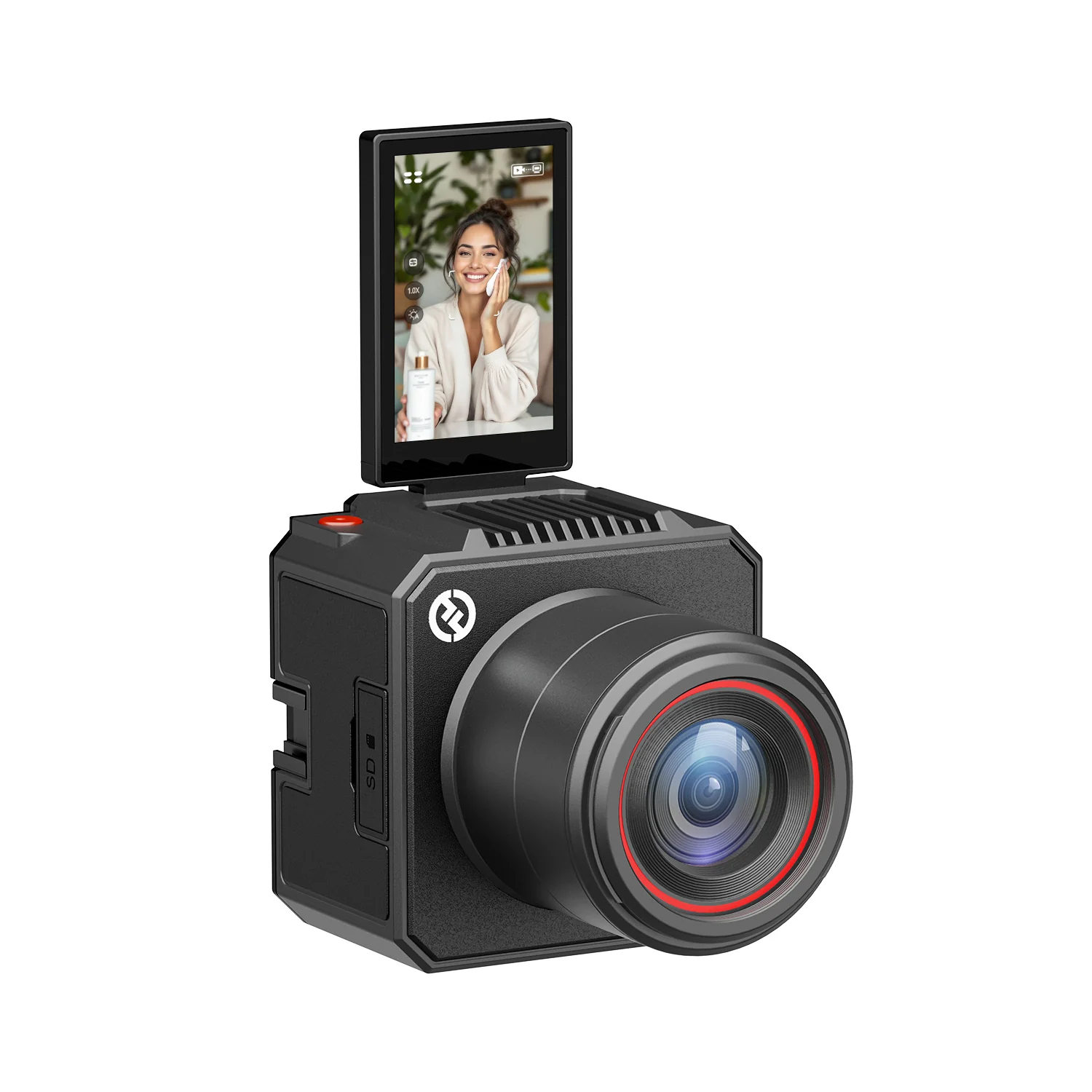
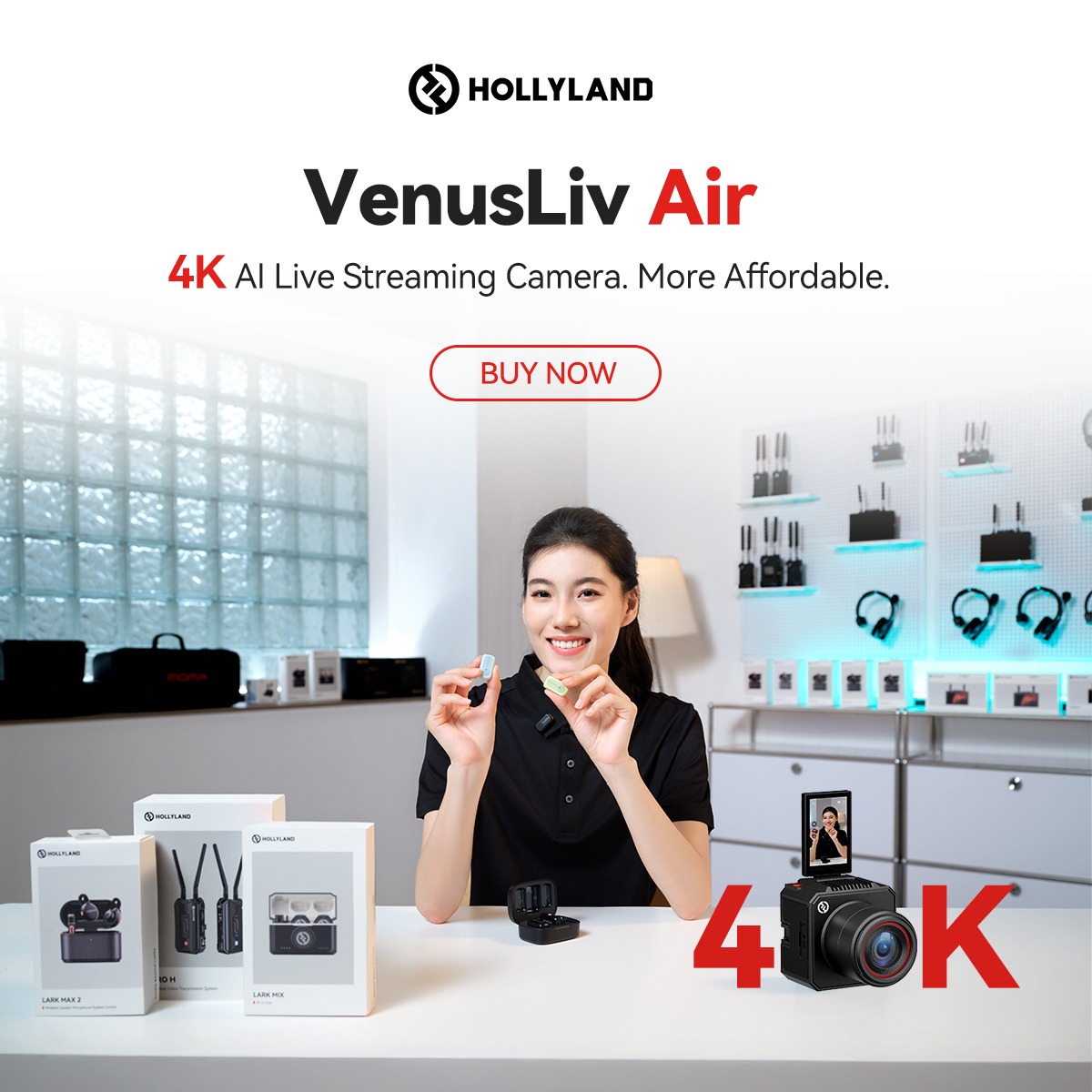
Hollyland VenusLiv Air - Compact 4K Streaming Camera
A compact, all-in-one 4K live streaming camera with a large sensor and fast lens, featuring AI-powered tools.
Key Features: 4K30 | 1/1.3″ CMOS | AI Tuning | 24/7 Streaming
One common issue in digital cameras is overheating when used for long hours. But, with VenusLiv, you can say goodbye to all the hurdles between you and your creativity. This camera has a cutting-edge aerospace-standard heat vacuum system that prevents the device from unexpected shutdowns and frame stuttering. This permits you to record or stream even 24/7 on all streaming platforms, including Twitch, YouTube, and Facebook. Also, the RTMP function lets you broadcast film-like streams in a single click.
Conversely, VenusLiv has USB Video Class (UVC) functionality that allows you to record professional-grade movies directly on your computer and stream from your laptop. This camera is also powered by HollyOS, which gives you more opportunities as a creator. For instance, you can adjust ISO, white balance, exposure, and aperture without experiencing a complicated menu system.
Pros:
- The camera covers wide angles due to multiple field-of-view (80-degree and 46-degree) horizontal and vertical
- The dual power supply (DC power and NP-F batteries) lets you use the camera indoors and outdoors without interruption
- Due to the Sony CMOS sensor, this camera captures high-quality images with outstanding sharpness, lighting, and next-level visuals
Cons:
- Users find its price a bit higher
- The camera is widely known for its video-capturing qualities rather than still photography
What’s more? The real-time autofocus and color correction magic tool are the next features that do the magic to make your content look like a film. These functions can make your videos more like a real film. But that’s not the end of the story! VenusLiv offers CalMAN color calibration, which allows you and your audience to enjoy true-to-life scenes. The Hollyland VenusLiv can be used via LAN, Wi-Fi, and Bluetooth connections.
Quantitative Measurements
- Connectivity: 9.5/10
- Materials: 8.5/10
- Portability: 8/10
- Uniqueness: 9/10
Conclusion
Digital Cameras revolutionized industry standards with their film-like aesthetics and eliminated the need for bulky film cameras. Advanced image processing technology ensures creativity, wider color grading, and premium image quality. So, selecting a digital camera depends on personal choices and primarily on budget considerations.
Therefore, after careful consideration, this guide provides the best available cameras to provide crisp, clear pictures. After carefully analyzing the features, you can select and explore the film world through digital cameras.
Frequently Asked Questions
What is the difference between CCD and CMOS Image Sensor?
CCD and CMOS convert light to electrons or electrical signals by capturing the incoming light. However, there is a difference in how both sensors quantify the signals.
- CCD: Once the industry standard, CCD employs an electrical charge transfer process to capture images. With this, it’s essential for producing high-quality, detailed, and low-noise photos.
- CMOS: Its advanced technology ensures faster signal processing and lower energy consumption. Despite its image-noise drawback, it is widely accepted globally because of advanced technology and cost-effectiveness.
How do I get film-like photos on my digital camera?
Digital cameras break traditional boundaries to ensure aesthetic photography for convenient and nostalgic film simulations. Therefore, digital cameras with advanced settings have the characteristics of simulation with deep-induced colors.
- First, lower your contrast from your settings, then decrease the sharpness.
- Then, shoot at different ISO modes from 200-1600 to get profound style effects and shoot within the limits for better quality.
Along with this, a careful understanding of the shadow of films and injecting colors in the shadow is crucial. Fujifilm digital cameras have built-in film simulations and are preferred to create film-like pictures.
Is digital photography cheaper than film?
Film photography has consistent costs over time because the continuous buying of film rolls will add up every year. Besides this, digital cameras provide freedom with their lightweight design and allow unlimited photos.
In addition, the same memory card can be reused after clearing some space over the years. However, some professional photographers still believe that film cameras provide better images with higher details.
• Panasonic Lumix G100
• Sony Alpha ZV-E10
• Canon SD 1000
• Fujifilm X-Pro 3
• Lumix LX3
• Canon EOS 2000D
• Canon 40D
• Canon 40 D

































.png)





